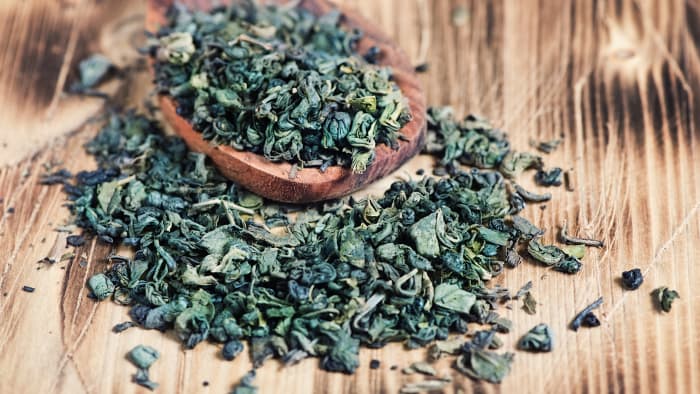Your tea is totally chemical! And this is normal
Green tea comes from the leaves of the same plant as black tea does. They become different after they are harvested, and human intervention determines what the drink will be like.

Green tea comes from the leaves of the same plant as black tea does. They become different after they are harvested, and human intervention determines what the drink will be like. Tea consists of the dried leaves and buds of the plant Camellia sinensis. Polyphenols constitute up to 40% of the mass of a tea leaf. The other 60% is made up of amino acids, proteins and methylxanthines (for example caffeine), vitamins and non-organic substances. Tea also contains trace amounts of volatile organic substances. They have a strong influence on the flavor and aroma of the drink.
Many volatile organic substances that determine the aroma of tea only arise in the course of enzymic oxidation. This is the stage of treating the leaves which determines whether the tea will be black or green. Slightly dried tea leaves are placed in a room with a controlled climate for a certain time. The polyphenols contained in the tea leaf are oxidized by the oxygen in the air in the presence of special enzymes – oxidases. Two of these polyphenols – epigallocatechin and epigallocatechin gallate (the most powerful antioxidants in tea) transform into thearubigins. These substances also have antioxidant properties. And they also give black tea its reddish color.

This means that the color of the tea depends on the length of enzymic oxidation. For example, tea that is intended to be green is barely oxidized at all. Almost immediately after the leaves are picked, they are treated with a jet of steam vapor, or sometimes simply heated in a pan. The high temperatures deactivate the oxidases. White tea is in second place by its degree of oxidation. It gets its name from the appearance of the tea bud, which is thickly coated with white fluff.
In third place is yellow tea. This rare sort is made from the finest leaves, and only in China. It is made in a very similar way to green tea, but with an additional step: the leaves are treated with steam under a wet fabric. This process is what makes them yellow.
Next in the ratings comes oolong tea. To make oolong tea, fermentation is not carried out completely, and the entire tea leaf is not oxidized, only the edges and part of the surface. Nevertheless, ideally about half of the leaf should be oxidized. It is thought that oolong combines the properties of green tea (a striking aroma) and black tea (a rich flavor).
To make black tea, leaves are oxidized by traditional technology from two weeks to one month. In China, this tea is called red (after the color of the drink), while the European name came from the color of the leaves before they are brewed.
And finally, the most fermented tea is pu’er. It is intentionally aged, to give it a characteristic earthy taste. There are several ways of doing this. One method is to gather the tea leaves in a bunch, sprinkle them with water, and cover them with a cloth. Some mold fungi are also involved in the treatment process. The process of preparing quality pu’er tea lasts at least a year. This sort of tea is called black tea by the Chinese.

Synthetic reagents or solvents are not used in the manufacture of tea. The only secondary products of oxidation are water and carbon dioxide. So tea can be considered to be the purest product of all the ones that we consume.
Besides its treatment, the taste and aroma of tea depends on the place where it grows. For example, in China the subspecies of the tea plant Camellia sinensis sinensis grows, which prefers high altitudes and relatively low temperatures. The plant from the Indian state of Assam belongs to the subspecies Camellia sinensis assamica. It grows in valleys, at high temperatures and in high humidity. All of this affects its chemical composition. Assam tea is considered to have a tarter and harsher flavor than tea made from the leaves of Camellia sinensis sinensis.
The chemical composition of treated tea leaves also depends on whether the leaves are kneaded (macerated) by hand or machine. The purpose of the process is to destroy the cellular structure inside the leaves and provide greater contact of polyphenols, oxidases and oxygen. There are two types of maceration: traditional, when people rub the leaves manually on bamboo trays or in baskets, and mechanical, when the tea leaves are rolled, crumpled and torn by special equipment. In the second case the cellular walls are destroyed less delicately, and the damage is much greater, Oxidation takes place more actively. As a result, tea made of leaves that are treated manually is more aromatic but lighter in color, while tea that is treated mechanically is strongly colored, but has a weaker aroma. Of course, mechanically treated tea is cheaper, while manually treated tea is considered to be of high-quality, and is accordingly more expensive.
Tea bags are sometimes filled with so-called screenings (very fine particles of tea leaves), or even tea powder – the finest and cheapest sort of tea. Although this powder gives a cup of tea a good color (and also the cup itself), it usually doesn’t stand out for its flavor and aroma.
Adding milk to tea reduces its health properties. The proteins contained in milk, caseins, form compounds with the polyphenols of tea, making them difficult to digest. But at least the milk cools the tea down. And let’s admit it: we like this mixture of tannins, methylxanthines and oxidized polyphenols most of all for its taste, while its health benefits take second place.